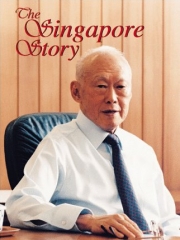The Singapore Story by Lee Kuan Yew
It’s been six months since I moved to Singapore. Even though I’ve barely spent time here, I still feel like I’m home every time I land at Changi. When I was sorting out housing before the move, I seriously considered not renting a place and just getting an Airbnb or hotel whenever I’m in Singapore. I’m glad I ended up renting. The per-day cost is high, but mentally it makes such a big difference.
There’s no doubt Singapore is one of the most impressive societies I’ve seen. It’s incredible that this country is only 50 years old. Everything works and is extremely organized. It feels somewhat like an urban utopia. But that’s not to say it’s necessarily superior to other places. Before coming here, I had read a lot about the pros and cons of Singapore. I repeatedly saw weather and “sterile” as the worst parts of Singapore. And it’s true. It’s hot and humid all the time, and it rains everyday. Recently, I’ve noticed how many of the ads around are for government programs or initiatives. Even my FB feed is inundated with Gov.sg ads. Here, the government plays a huge role in daily life. Combining this with the muggy weather, it can feel like a trap. The good thing is that, at least to outsiders like me, the Singapore government is very competent and well-meaning. It’s hard to argue that the government is doing a bad job, considering how Singapore has turned out. Since this all started with Lee Kuan Yew, I read this book to learn more about how Singapore became what it is today.
1) Lee Kuan Yew grew up during the Japanese invasion, which served as the foundation for some of his thinking.
For one, the Japanese showed him that the British were not unbeatable. Colonialism no longer made sense. Secondly, he believed in punishment because he saw that it was effective. Also, the Sook Ching Massacre contributed to the strong Chinese identity that drove much of the politics in Singapore, and later with the Federation of Malaya.
2) He met his wife while running a stationery gum business with her brother.
Stationery gum is not chewing gum, but the irony is not lost.
3) The post-war Chinese community looked to China and were receptive to communism.
The threat of communism was the key factor in how a lot of Singaporean politics played out. Lee Kuan Yew had to win the Chinese vote without being communist, and the British interfered with affairs to ensure that Singapore would not turn communist.
4) LKY made sure that his children were educated in Chinese schools.
Education is so important because it shapes people’s thoughts and values from a young age.
5) After returning from Cambridge, LKY started off as a lawyer for trade and student unions.
He became famous during the government arrests of students, and he formed the People’s Action Party (PAP), originally a mix of communists and non-communists. To this day, PAP is still the ruling party.
6) The Singapore flag is a mix of Chinese and Malay symbols.
The crescent moon for Malays and the five stars for Chinese. Vexillology is amazing.
7) A referendum was held for the Singaporean public on the topic of merger with Malaya.
71% supported LKY’s proposal, while 25% cast blank votes. LKY did not allow No votes.
8) The merger was combined with North Borneo and Sarawak so that the ratio of Malays and Chinese wouldn’t be upset.
The struggle for power between Malays and Chinese was the key problem in the merger.
9) Indonesia launched the Confrontation to protest the creation of Malaysia.
I’d like to read more on Indonesia and its relationship with the other countries in SEA.
10) Ultimately, Goh Keng Swee and LKY secretly worked with Malay leaders to finalize the separation of Singapore.
The UMNO and PAP got involved in the politics of each other’s base. Also, the terms around taxes and defense were never satisfactory to either party. As LKY says, the Tunku saw him as too much of a threat to potentially take over the entire Malaysia, so the Tunku had no choice but to kick Singapore out.
As LKY put it, Singapore is an island of Chinese surrounded by islands of Malays. Before this book, I hadn’t really registered how odd this was. Singapore feels so different from China that I never viewed the Chinese people here from an ethnic angle. One of the best parts of Singapore is its multiracialism. It wasn’t easy for Singapore to become independent, and unfortunately racial issues won’t go away any time soon.
